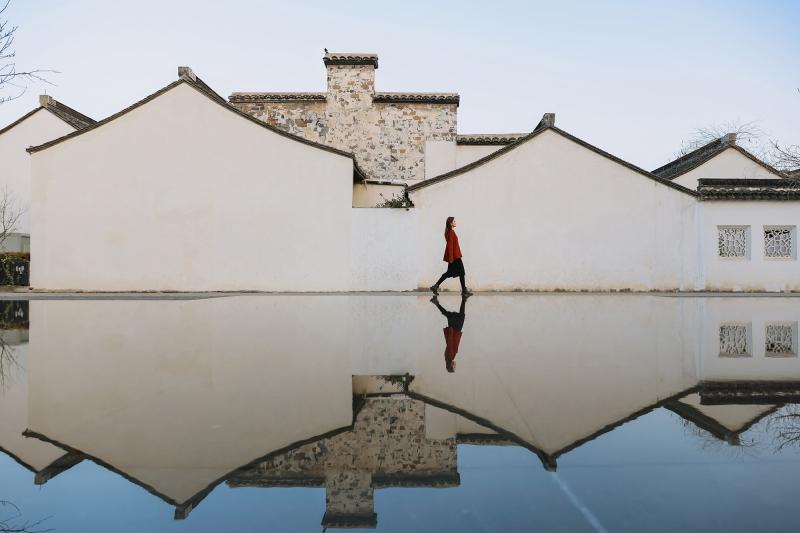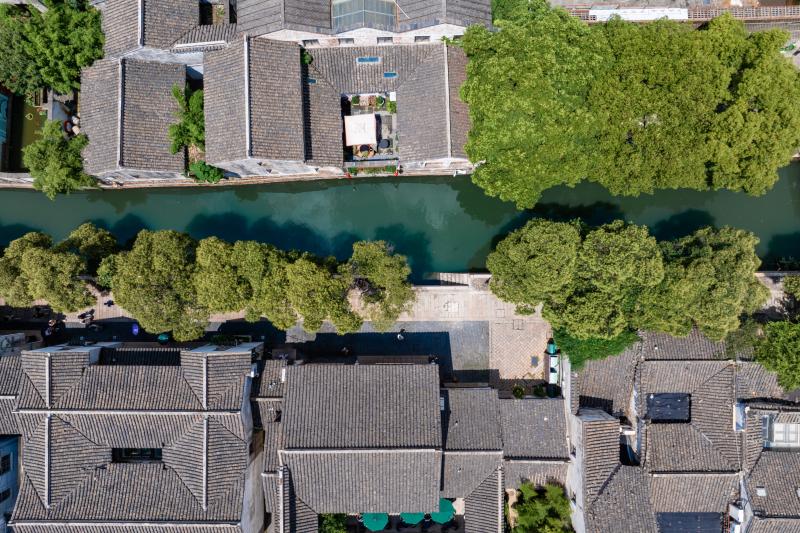Looking at Jiangsu along the Grand Canal - Cultural and Tourism Chapter History | Culture | Cultural and Tourism
The Grand Canal not only undertakes important water conservancy functions, but also nurtures many beautiful natural landscapes and profound cultural landscapes along the way. Please follow the footsteps of CCTV to explore the cultural heritage of the canal and experience the painting of the canal.
Canal Three Bay Ecological and Cultural Park
The Yunhe Sanwan Ecological and Cultural Park is located in the ancient Yunhe Sanwan section of the southeastern area of Yangzhou. It is a comprehensive park that integrates ecological protection, cultural heritage, science education, leisure and tourism, and is one of the top ten ecological centers in Yangzhou, relying on the scenery of the Yunhe Sanwan and surrounding wetlands. The total planned area of the park is 3800 acres, with a built-up area of approximately 1520 acres.
In August 2021, Sanwan Ecological and Cultural Park was selected as the first "Most Beautiful Ecological Restoration Case" in Jiangsu Province.

For thousands of years, the canal has nurtured cities and people on both sides, serving as a river of wealth and happiness for the people on both sides of the canal. I hope everyone can protect the Grand Canal together, so that it will always benefit the people.
On June 16, 2021, the China Grand Canal Museum, located on the banks of the Sanwan Guyun River, was completed and opened to the public. The total area of the museum is about 79000 square meters, including the exhibition hall, Dayun Tower, and Jinyue Bridge. Climbing the tower can overlook the historical landscape of "Three Bays Arriving at One Dam". The museum has a total of 14 distinctive exhibition spaces, where visitors can learn about the historical changes of the Grand Canal and its important significance for ancient Chinese politics, economy, and culture. They can experience the intelligence and talent of ancient Chinese hydraulic engineering and the beautiful life brought by the Grand Canal, gain knowledge about shipbuilding technology, local customs, and the natural ecology along the route, and appreciate the wisdom and philosophical ideas of the relationship between humans and nature in Eastern civilization. This is the preferred place for people to experience the charm of canal heritage and enjoy cultural leisure.
Hexia Ancient Town
The Hexia Ancient Town, formerly known as Beichen Town, is located in Hexia Street, Huai'an District, Huai'an City, Jiangsu Province. It is situated on the northwest border of Huai'an District and is one of the scenic spots of Zhou Enlai's hometown. The ancient town was formed in the late Spring and Autumn period and has a history of about 2500 years. During the Ming and Qing dynasties, there were 123 Juren, 67 Jinshi, and 12 Hanlin here, known as the "complete set of three tripods and armor".

Hexia Ancient Town has attractions such as Huzui Street, the former residence of Wu Cheng'en, Wu Jutong Traditional Chinese Medicine Museum, Zhuangyuan Building, Wenlou, and Wensi Temple. The main delicacies include Changyu Banquet, Tangbao, and Chasan.
In July 2002, Hexia Ancient Town was designated as one of the first 30 key protected historical districts in China by the Ministry of Construction and the Ministry of Culture. In October 2015, Hexia Ancient Town, as an important component of Zhou Enlai's hometown scenic area, was rated as a national 5A level tourist attraction.
Qingguo Lane Historical and Cultural Block
The Qingguo Lane Historical and Cultural Block is located at the core of the old city of Changzhou, adjacent to the oldest section of the Beijing Hangzhou Grand Canal, Changzhou Nanshi River, which is a world cultural heritage site. It is the most well preserved and famous ancient street and alley in the urban area of Changzhou since the Ming and Qing dynasties.

A Qingguo Lane, half of Changzhou's history. Qingguo Lane unfolds in a comb like pattern along the ancient canal, presenting a spatial pattern of "deep houses and large courtyards adjacent to each other, with flowing water and houses reflecting each other" and the unique style of traditional residential buildings in the water towns of Jiangnan. The alleyway is mainly composed of buildings from the Ming, Qing, and Republican periods, with famous residences, temples, bridges, stone tablets, Lin Quanxuan pavilions, ancient well piers, theaters and theaters, and school buildings. It is a living fossil of Changzhou, a national historical and cultural city.
If the pink walls and black tiles depict the Jiangnan style of Qingguo Lane, then the emergence of famous scholars carries the elegant charm of Qingguo Lane. Here, the literary style flourished during the Tang Dynasty, with aristocratic families living in hairpins and tassels. The fragrance of books filled the alleys, and ink drifted across the river. For thousands of years, Qingguo Lane has nurtured over a hundred Jinshi and a large number of famous scholars such as Tang Jingchuan, Sheng Xuanhuai, Qu Qiubai, Zhao Yuanren, Zhou Youguang, etc. It is known as the "First Lane of Famous Scholars in Jiangnan".
In order to better inherit the thousand year history and rich cultural heritage of Qingguo Lane, the Qingguo Lane Historical and Cultural Block has carefully built major exhibition halls, including the Qingguo Lane Cultural Memory Museum, Shiliang's Former Residence, Zhou Youguang Library, Zhao Yuanren Art Center, Tang Jingchuan Memorial Hall, Changzhou League History Museum, and Red Qingguo Hall, as well as a "1+7+N" group of famous museums and numerous cultural relic signs distributed on the streets and alleys, providing a place and channel for citizens and tourists to understand local culture, allowing people to appreciate history from the evolution of architecture and spatial layout.
Wumen Wangting Canal Park

Wumen Wangting Canal Park covers an area of approximately 200000 square meters, with a landscape area of 175000 square meters and a building area of 20000 square meters. It is a typical example of implementing rural cultural revitalization in Suzhou City. The Wangting Historical and Cultural District is located within the Canal Park, covering an area of approximately 11000 square meters. It has three cultural themed exhibition halls: "Millennium Wangting", "Wangyun Pavilion", and "Wangting Post", reproducing the style of the ancient imperial pavilion as the "First Town of the Canal Wumen". The Wangting Historical and Cultural District not only restores the prosperous style of the old site, but also combines the cultural characteristics of the canal to create a comprehensive commercial area that integrates leisure sightseeing, cultural and creative markets, creative trendy shops, intangible cultural heritage, Soviet style snacks, and tourism services.
Among them, the Wangting Town Geography Museum was established in 2013, with an overall shape of a "round warehouse", taking the spirit of "container" and integrating the cultural heritage of the Chinese nation, which embodies the long-standing historical crystallization and cultural essence of Wangting. The museum has a collection of 692 cultural relics, including Neolithic stone tools, Liangzhu jade bi, Spring and Autumn and Warring States bronze artifacts, Han, Tang, Song, Ming and Qing ceramic artifacts, including 5 national second level cultural relics, 275 national third level cultural relics, and 412 general and unclassified cultural relics.
Pingjiang Historical Block
The Pingjiang Historical District in Suzhou is located in the northeast corner of the ancient city of Suzhou. It starts from the Outer Ring River in the east, ends at Linton Road in the west, ends at Ganjiang Road in the south, and ends at Baita East Road in the north. The area is approximately 116.5 hectares, and the total length of the main street is 1092 meters. The Pingjiang Historical Block fully preserves the double chessboard pattern of "parallel water and land, adjacent rivers and streets" designed by Wu Zixu of the State of Wu during the construction of the Helu Grand City in 514 BC, as well as the unique style of "small bridges and flowing water, pink walls and black tiles". It can be regarded as a microcosm of the ancient city of Suzhou and a vivid "Song Dynasty Pingjiang Map". In recent years, Suzhou Pingjiang Historical District has successively won honors such as the "Asia Pacific Cultural Heritage Protection Honorary Award", "First Batch of Chinese Historical and Cultural Famous Streets", "Outstanding Contribution Award for Chinese Ethnic Architecture Protection", and "First Batch of Chinese Historical and Cultural Blocks". It is also an important component of awards such as the "Lee Kuan Yew World City Award" and "National Ancient City Tourism Demonstration Zone". Since the launch of the pilot project for Pingjiang Road landscape protection and environmental improvement in 2002, under the guidance of scientific planning, the local government has adopted various methods such as overall protection, partial preservation, and major renovation according to the basic requirements of maintaining the ancient city pattern, showcasing traditional style, beautifying environmental landscapes, and inheriting historical and cultural heritage. The block's architectural form and spatial pattern have been fully preserved, while strictly controlling the overall style of the building to maintain the local characteristics of small size, light and delicate shape, light color, and pink walls and black tiles. As a result, a number of high-end case resources such as "Pingjiang Inn Dong's Yizhuang", "Mingtang Inn and Cafe", and "Hanxiang Society" have been formed, including the restoration of architectural heritage, reuse of ancient buildings, and protection of traditional cultural spaces. At the same time, a cultural space has been created that preserves and inherits traditional lifestyles and customs.





